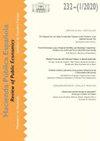The Relationship between Public Expenditure and Private Investment in Developed and Developing Economies: Policy Implications Based on the Difference
IF 0.5
4区 经济学
Q3 ECONOMICS
Hacienda Publica Espanola-Review of Public Economics
Pub Date : 2023-03-01
DOI:10.7866/hpe-rpe.23.1.2
引用次数: 0
Abstract
ublic spending is one effective instrument of fiscal policy in both developed and developing countries. Governments use it to overcome the cyclicality of the economy and to run the economy. However, it can crowd in or crowd out private investment. Is there a difference in the public expenditure – private investment relationship between developed and developing countries? This study looks for an answer by empirically investigating the effect of public expenditure on private investment for a group of 36 developed countries and a group of 98 developing countries from 2002 to 2019. The results by the two-step difference GMM Arellano-Bond estimator seem to be counter-intuitive. Public expenditure crowds out private investment in developed countries but crowds in it in developing countries. The study uses the FE-IV estimator and the PGM estimator to check the robustness of these estimates. The study suggests some arguments to explain the validity of the counter-intuitive results and policy implications for governments in both developed and developing countries.发达经济体和发展中经济体公共支出和私人投资的关系:基于差异的政策含义
公共支出是发达国家和发展中国家财政政策的有效工具。政府用它来克服经济的周期性和运行经济。然而,它可以挤进或挤出私人投资。发达国家和发展中国家之间的公共支出-私人投资关系是否存在差异?本研究通过对2002年至2019年36个发达国家和98个发展中国家的公共支出对私人投资的影响进行实证调查,寻求答案。两步差分GMM Arellano-Bond估计器的结果似乎是反直觉的。在发达国家,公共支出挤占了私人投资,但在发展中国家,公共支出挤占了私人投资。研究使用FE-IV估计器和PGM估计器来检查这些估计的鲁棒性。该研究提出了一些论据来解释反直觉结果的有效性以及对发达国家和发展中国家政府的政策影响。
本文章由计算机程序翻译,如有差异,请以英文原文为准。
求助全文
约1分钟内获得全文
求助全文
来源期刊

Hacienda Publica Espanola-Review of Public Economics
Economics, Econometrics and Finance-Finance
CiteScore
0.90
自引率
14.30%
发文量
14
期刊介绍:
Hacienda Pública Española/Review of Public Economics welcomes submissions on all areas of public economics. We seek to publish original and innovative research, applied and theoretical, related to the economic analysis of Government intervention. For example, but not exclusively: Taxation, Redistribution, Health, Education, Pensions, Governance, Fiscal Policy and Fiscal Federalism.
In addition to regular submissions, the journal welcomes submissions of:
-Survey Reviews, containing surveys of the literature regarding issues of interest in the Public Economics field;
-Policy oriented reviews, showing the current contributions of Public Economics in relation to relevant contemporary issues affecting public decision-makers in the real world (Policy Watch);
-Comments of previously published articles. Contributions to this section should be limited to a maximum of 2 000 words (12 pages). If deemed adequate, the authors of the commented article will be given the opportunity to react in a Reply. Both Comment and Reply will be published together.
Articles for the Survey Reviews and Policy Watch section are subject to the same double blind reviwing procedure. The adequacy of Comments submitted for publication will be evaluated by the Executive Editors.
 求助内容:
求助内容: 应助结果提醒方式:
应助结果提醒方式:


